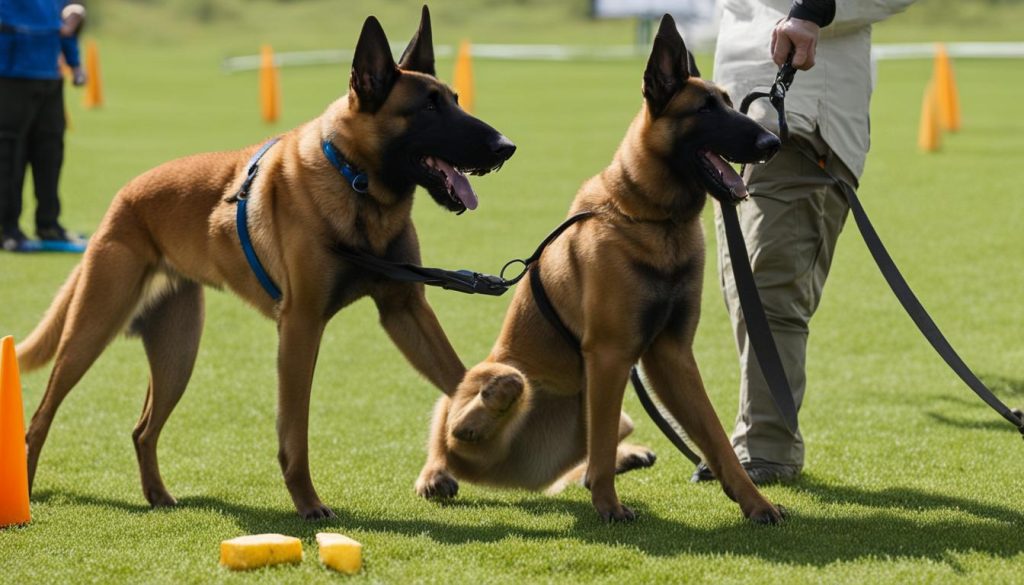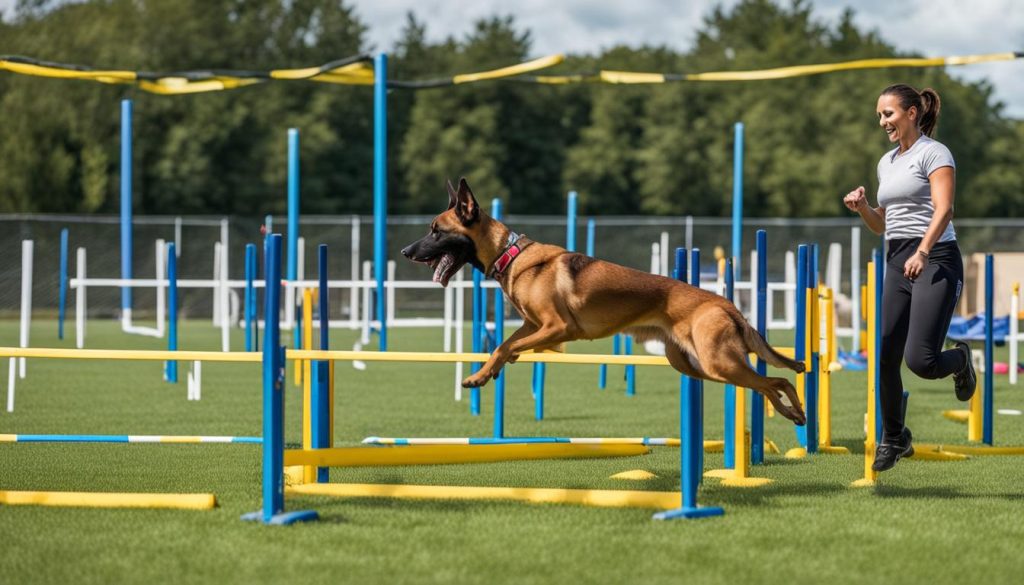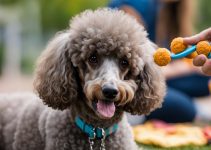Training a Belgian Malinois can be a rewarding and fulfilling experience. This versatile and intelligent breed requires firm and consistent training to ensure they become well-behaved and obedient companions. Whether you are focusing on obedience training, behavior training, or simply teaching them basic commands, there are several key tips to keep in mind for a successful Belgian Malinois training journey.
Belgian Malinois Training
- Start training as early as possible to set rules and expectations.
- Ensure proper socialization to different people, places, and experiences.
- Use reward-based training and positive reinforcement to motivate and engage your Belgian Malinois.
- Control their prey drive and redirect their energy to prevent unwanted behavior.
- Consider clicker training techniques for effective obedience training.
Socializing Your Belgian Malinois
Socializing a Belgian Malinois is crucial for their development and well-being. Early socialization, between 4 to 18 weeks old, plays a vital role in helping them become well-adjusted dogs. By exposing your puppy to different places and people during this critical period, you can help them adapt to new environments and experiences.
Taking your Belgian Malinois on walks in public places allows them to encounter various stimuli and learn how to navigate different situations. Introducing them to friends and family members helps them build positive associations with new people. The goal is to make your dog feel comfortable and confident when encountering strangers and interacting with other dogs.
Dog parks and obedience classes are excellent opportunities for socialization. These environments provide controlled settings where your Belgian Malinois can interact with other dogs under supervision. This interaction promotes positive social behavior and helps prevent fear and aggressiveness toward uncertain situations.
Socializing your Belgian Malinois early on lays the foundation for them to become friendly and well-behaved companions. It also helps to minimize behavior problems that may arise from fear or anxiety. By exposing your dog to a variety of people, places, and experiences, you are shaping their social skills and ensuring they grow up to be confident and well-adjusted adults.
Remember to take a moment to appreciate the adorable curiosity of a Belgian Malinois puppy as they embark on their journey of exploring new experiences, people, and environments. With proper socialization, you are setting them up for a lifetime of happiness and positive interactions.
Positive Reinforcement Training
Positive reinforcement is a highly effective and humane training technique that works wonders for Belgian Malinois. Instead of resorting to punishment for undesired behavior, the focus is on rewarding good behavior with praise, treats, or a clicker. This approach motivates the dog and keeps them engaged during training sessions.
One of the primary rewards used in positive reinforcement training is food. By using food as a motivator, you can keep your Belgian Malinois focused and interested. Treats should be small and tasty, so they don’t distract the dog from the training process.
This technique is particularly useful for teaching essential commands such as “sit,” “down,” “leave it,” and heeling. By consistently rewarding the correct response to these commands, you reinforce the behavior and make it more likely to recur in the future.
It is essential to keep your Belgian Malinois training sessions short and fun, especially when working with young Belgian Malinois. Starting with brief periods and gradually increasing the duration as the dog gets older and more experienced will help maintain their focus and prevent boredom.
Positive reinforcement training not only helps shape desired behaviors but also builds a strong bond between you and your Belgian Malinois. By creating a positive learning environment, you establish trust and mutual respect, leading to even more successful Belgian Malinois training outcomes.

Prey Drive Control
Belgian Malinois are known for their strong prey drive and herding instincts. It’s important to control these behaviors to ensure the safety of the dog and those around them. Through socialization and training, we can help minimize their instinct to chase small animals or herd people.
One effective technique is teaching the dog to “leave it” when encountering potential prey. This command redirects their energy and helps them understand that certain behaviors are not acceptable. Providing mental and physical stimulation through interactive toys, puzzle games, and regular exercise can also help satisfy their natural drive.
During walks, it is important to keep the dog on a leash to prevent them from chasing after animals. Leash training allows you to maintain control and redirect their attention towards appropriate activities.
Consistency is key when it comes to Belgian Malinois training. By providing positive reinforcement, such as treats and praise, we can reinforce desired behavior and discourage unwanted herding instincts.
Preventing herding behavior in Belgian Malinois:
- Teach the “leave it” command to redirect their attention away from herding people or other animals
- Engage in regular mental and physical exercise to stimulate their minds and redirect their energy
- Use appropriate toys and puzzles to keep them engaged and satisfied
- Keep the dog on a leash during walks to prevent them from chasing after prey
- Provide positive reinforcement to reinforce desired behavior
By following these strategies and maintaining consistent training, you can effectively control the prey drive and herding behavior in your Belgian Malinois, ensuring a well-behaved and safe companion.
Obedience Training Techniques
When it comes to Belgian Malinois training, obedience is a key component for a well-behaved and responsive dog. One effective technique that can aid in this process is clicker training. This method utilizes a distinct clicking noise paired with rewards to help your dog understand when they have successfully completed a desired behavior.
Clicker training can be used to teach new commands and tricks, providing mental stimulation and strengthening the bond between you and your furry friend. By consistently associating the clicker sound with positive reinforcement, such as treats or praise, your Belgian Malinois will quickly grasp the desired behavior.
In addition to clicker training, it is important to incorporate verbal cues and hand signals to enhance obedience training. Common commands like “sit,” “stay,” and “come” can be taught using repetition and positive reinforcement. Consistency is key in reinforcing these commands, ensuring your Belgian Malinois responds reliably in various situations.
If you are new to training or feel you need assistance in refining your dog’s obedience skills, consider seeking professional training. With their expertise, trainers can provide guidance and personalized techniques to help you and your Belgian Malinois excel in obedience training.
Remember, patience and consistency are essential throughout the training process. By implementing clicker training and using verbal cues with positive reinforcement, you can create a well-trained and responsive Belgian Malinois that is a joy to be around.
Exercise and Mental Stimulation
Belgian Malinois are known for their boundless energy and require daily exercise to keep them happy and well-behaved. It is recommended to provide them with at least 60-90 minutes of physical activity each day. Regular exercise not only helps prevent unwanted behavior but also contributes to their overall well-being.
There are various activities that you can engage in to exercise your Belgian Malinois. Running, biking, and hiking are excellent options that allow them to release their pent-up energy. In addition, participating in dog sports like agility can provide mental and physical challenges, ensuring that they stay stimulated and focused.
To keep your Belgian Malinois mentally stimulated, it’s important to provide them with appropriate toys and interactive playtime. Puzzle toys can engage their minds and encourage problem-solving skills. Interactive play sessions, such as playing fetch or hide-and-seek, can also help keep their minds sharp and provide a bonding experience between you and your furry friend.
The Importance of Exercise and Mental Stimulation
- Regular exercise helps prevent destructive behavior by channeling their energy in a positive way.
- Mental stimulation is essential to prevent boredom, which can lead to behavioral issues.
- Engaging in physical activities strengthens the bond between you and your Belgian Malinois.
- Providing mental challenges through interactive play keeps their minds sharp and agile.
- Exercise and mental stimulation contribute to the overall well-being and happiness of your Belgian Malinois.
Remember, a tired dog is a happy dog. By ensuring that your Belgian Malinois gets enough exercise and mental stimulation, you can enhance their quality of life and create a harmonious living environment for both of you.
Continuing Training and Consistency
Belgian Malinois training is an ongoing process that requires continued training and consistency. As an owner, it’s important to understand that training should not stop once the basic commands are learned. Advanced training for Belgian Malinois can further develop their skills and strengthen the bond between you and your dog.
Advanced Obedience Classes and Agility Training
One way to take your Belgian Malinois training to the next level is by enrolling them in advanced obedience classes. These classes are designed to challenge the dog and improve their obedience skills. Professional trainers will guide you in refining your dog’s training techniques and addressing any specific behavior issues.
Additionally, agility training is an excellent way to provide mental and physical stimulation for your Belgian Malinois. These training sessions involve navigating through obstacles, jumping over hurdles, and following commands swiftly. Agility training not only helps develop your dog’s coordination and agility but also boosts their confidence and focus.
Maintaining Training Consistency
Consistency is key when it comes to training a Belgian Malinois. It’s essential to use the same commands, gestures, and hand signals consistently to avoid confusion. By maintaining a consistent training routine, your dog will learn to respond reliably to your commands in various situations.
It’s also important to note that training consistency extends beyond the training sessions. Reinforcing the training principles throughout your daily interactions with your Belgian Malinois will help solidify their learned behaviors and prevent regression.
Reinforcing Good Behavior and Discouraging Improper Behavior
While positive reinforcement is effective for teaching basic commands, there may be instances where negative reinforcement is necessary to correct unwanted behaviors in your Belgian Malinois. Leash training and the use of an e-collar can be effective tools in reinforcing good behavior and discouraging improper behavior.
However, it’s crucial to use these methods responsibly and under the guidance of a professional trainer. They can help you understand the proper techniques and ensure the safety and well-being of your dog during the training process.
By continuing your Belgian Malinois’s training and maintaining consistency, you can further enhance their skills and strengthen your bond. Whether through advanced obedience classes or reinforcing good behavior, investing in professional Belgian Malinois training can help you achieve the desired results.

Conclusion
Training a Belgian Malinois requires time, patience, and consistency. Starting early with socialization and positive reinforcement sets the foundation for a well-behaved dog. Understanding the dog’s needs, providing mental and physical stimulation, and using appropriate training tools like clickers and collars are essential. Obedience training and controlling prey drive can ensure the dog’s safety and prevent undesirable behavior. Professional training may be necessary for advanced skills. With commitment and proper training techniques, owners can develop a strong bond and enjoy a well-mannered Belgian Malinois companion.
FAQ
When should I start training my Belgian Malinois?
It is recommended to start training your Belgian Malinois as early as possible. Training should begin when they are puppies to establish rules and expectations.
How important is socializing my Belgian Malinois?
Socializing your Belgian Malinois is essential to help them become well-adjusted dogs. It is crucial to introduce them to new people, places, and experiences early on.
What is the best training technique for Belgian Malinois?
Positive reinforcement is an effective training technique for Belgian Malinois. Rewarding good behavior with treats, praise, or a clicker helps them understand what is expected of them.
How can I control my Belgian Malinois’ prey drive?
To control your Belgian Malinois’ prey drive, it is important to provide plenty of mental and physical stimulation. Redirecting their energy with toys and exercise can help minimize chasing and herding behavior.
What is clicker training, and is it suitable for Belgian Malinois?
Clicker training is a valuable technique for training Belgian Malinois. It uses a distinct clicking noise paired with rewards to reinforce desired behaviors, making it an effective training method.
How much exercise does a Belgian Malinois need?
Belgian Malinois are high-energy dogs that require at least 60-90 minutes of exercise daily to prevent unwanted behavior. Activities like running, hiking, and dog sports can help channel their energy.
Is ongoing training necessary for a Belgian Malinois?
Yes, training for a Belgian Malinois is an ongoing process. Consistency and continued training are necessary to reinforce good behavior and prevent regression.
Are professional trainers necessary for training a Belgian Malinois?
Professional trainers can be beneficial, especially for advanced training techniques and refining obedience skills. They can provide guidance and expertise to ensure successful training.
Is training a Belgian Malinois a challenging task?
Training a Belgian Malinois can be challenging due to their intelligence and energy levels. However, with patience, consistency, and proper training techniques, it is possible to have a well-behaved and obedient dog.
What are some tips for successful Belgian Malinois training?
Some tips for successful Belgian Malinois training include starting early, socializing them, using positive reinforcement, providing adequate exercise and mental stimulation, and maintaining training consistency.






